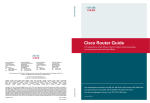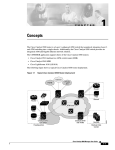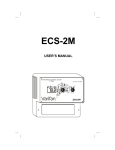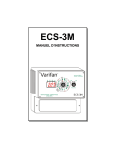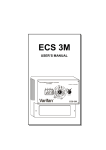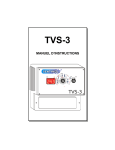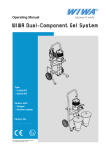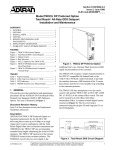Download Chrysler 2005 300 Automobile User Manual
Transcript
C H A P T E R 1 Concepts The Cisco 10000 series router offers a single solution for leased–line, ATM, frame relay, and broadband aggregation while providing customers with high–performance IP services, maximum platform scalability, and high availability. The Cisco 10000 Series Manager application supports the Cisco 10005 Edge Services Router (ESR) and the Cisco 10008 ESR. The following figure shows a typical Cisco 10000 deployment. Figure 1-1 Typical Cisco 10000 Deployment Leased lines Cisco 10K router Service provider Cisco ATM core 89823 Cisco IP core The Concepts chapter describes EM concepts and covers the following information: • EM Documentation Set • Cisco EMF Software Features • EM Software Features • EM Objects and Interfaces • Views • Object States Cisco 10000 Series Manager User Guide OL-3594-01 1-1 Chapter 1 Concepts EM Documentation Set EM Documentation Set This guide is one part of the Cisco 10000 Series Manager EM documentation set. The following figure displays all of the guides in the EM documentation set and details the contents of each. EM Documentation Set Cisco Element Management Framework Installation and Administration Guide (Release 3.2) Cisco Element Management Framework User Guide (Version 3.2) Cisco 10000 Series Manager Installation Guide (Release 1.0) Cisco 10000 Series Manager User Guide (Release 1.0) Describes how to install the Cisco Element Management Framework application and provides additional setup and licensing information. Describes how to use the Cisco Element Management Framework application. Describes how to install the Cisco 10000 Series Manager application and provides additional setup information. Describes how to use the Cisco 10000 Series Manager application. 89785 Figure 1-2 The guides identified in the preceding figure are available from Cisco Systems. For further information on obtaining Cisco documentation, see the “Obtaining Documentation” section on page -xv. Cisco 10000 Series Manager User Guide 1-2 OL-3594-01 Chapter 1 Concepts Cisco EMF Software Features Cisco EMF Software Features Cisco EMF provides a flexible framework which supports a variety of EMs, making it possible to manage multiple device types within a given network on a single system. Common network management functionality provides for complete management of the logical and physical components of the network. Using a solid base, Cisco EMF provides vital core functionality which allows for optimal network management when combined with EMs. Features include the following: • Map Viewer—Displays the contents of the managed device(s) and serves as the primary entry point for the EM, allowing for enhanced object monitoring status for all network elements within the managed network • Deployment templates—Provides object deployment prompts, increasing ease and consistency • Auto Discovery—Allows for the automatic discovery of devices entering the network based on IP and/or SNMP data • Event Browser—Notifies the system of events (e.g., alarms) which occur on the managed network and, in turn, notifies the network manager according to adjustable settings • Object Group Manager—Enables you to organize managed objects which relate to one another into groups • Performance Manager—Presents performance statistics for monitored objects in a variety of formats according to the criteria selected • User Access Control—Administration tool allowing system administrators to manage application privileges per user and user passwords • Query Editor—Provides custom filtering capabilities which include or exclude certain information from writing to the database and enables object group management • Notification Profiles—Warns the user of system events according to defined environmental occurrences through an audible or visual indicators (e.g., beep, display pop–up window), scripts (which, for example, sends an e–mail message), or event generation • Thresholding Regimes—Defines a set of polling attributes and the polling period for monitoring, which, when met, run the applicable notification profiles • Event Groups—Organizes events by managed object(s) according to query settings • Database Management—Maximizes the Resource Manager Essentials (RME) tool to manage database backup and restoration For further information on Cisco EMF and the tools it provides, see the following items: • The “Cisco EMF Launchpad” section on page 2-6 • The Cisco Element Management Framework User Guide Release 3.2 • Cisco EMF help windows available through the Help button or menu on the Cisco EMF Launchpad Cisco 10000 Series Manager User Guide OL-3594-01 1-3 Chapter 1 Concepts EM Software Features EM Software Features Installed with Cisco EMF, the EM allows for precise management of the device(s) it supports through custom GUI windows and modeling behavior. Invoked from the Cisco EMF Map Viewer application, the EM provides Fault, Configuration, Accounting, Performance, and Security (FCAPS) windows on chassis, module, interface, and connection levels as applicable. These windows provide the features which compliment the Cisco EMF capabilities to provide for complete, efficient network management. Specifically, the Cisco 10000 Series Manager supports the Cisco 10005 ESR and Cisco 10008 ESR chassis, as well as various modules which can accommodate ethernet, ATM, POS, SONET, and E3/DS3 interfaces. Element management capabilities for these items are provided in windows and wizards, eliminating the need for operators to have detailed Cisco IOS software and SNMP–based knowledge for individual interface or system parameter commands. The following features highlight the capabilities of the EM: • Framework—Based on Cisco EMF 3.2, which includes FCAPS management tools • IOS Versions—See the corresponding release note document for specific versions supported • Deployment and Discovery—Allows for manual or automatic deployment and discovery – Deployment—Supports manual deployment for generic objects, and pre–deployment of chassis objects using templates which provide faster deployment with fewer errors – Auto Discovery—Discovers chassis and all submodules automatically within a given IP range, providing real–time information regarding the contents of the network • Synchronization—Synchronizes the physical inventory model with managed NEs, providing accurate, real–time information on what is deployed in the network • Fault management—Provides status information, as well as fault detection, troubleshooting, and repair tools • Configuration—Provides base configuration for managed objects within the device, as well as: – Discovery—Allows for discovery of individual chassis and modules, or complete subchassis discovery – Preprovisioning—Enables configuration of predeployed modules not yet present in the chassis on the device via IOS commands and within the EM through window–based features – Restoration—Configuration backup functionality is available, enabling configuration restoration as required – Redundancy—Dual CPUs allow for fail–over backups and provide forced fail–over capabilities when needed – Profiles—Allows you to apply established configuration parameters to a bulk number of objects • Accounting—Provides real–time inventory information • Performance—Supplies real–time performance–related statistics as well as capabilities to log historical performance data for analysis • Security—Provides capabilities to manage system security at the EM or device level • Alarm Notification—Provides support of multiple traps, producing alarm notification per the criteria established Cisco 10000 Series Manager User Guide 1-4 OL-3594-01 Chapter 1 Concepts EM Objects and Interfaces EM Objects and Interfaces The EM manages both physical and logical objects as follows: • Physical—Represents tangible components and devices such as the chassis (hardware frame), module interfaces and port adapters, and interfaces • Logical—Represents intangible, more abstract features, such as ATM connections objects and profiles Fault, Configuration, Accounting, Performance, and Security (FCAPS) windows are accessible on both physical and logical EM objects, in the form of FCAPS menu options that appear when you right–click on any object in the EM. FCAPS functionality provides a complete management interface to features of the router. The EM uses Telecom Graphics Objects (TGO) in the Map Viewer application. TGO is a TeleManagement Forum (TMF) sponsored initiative to provide standard graphical representations for network topology maps. A TGO displays additional information icons on top of the existing object icons displayed in Map Viewer. The additional icons indicate a variety of information (for example, information on the state of the object or event status information). The following figure provides an example of a TGO. Figure 1-3 Sample Telecom Graphical Object An object is a representation of a network element. For example, the object could be a node, a shelf, a shelf item, or a link. Each object shown in the right window provides pictorial cues which provide information about its associated network element. The information can be structural information; for example, a network element name or state and event information such as “out of service.” Each object can display the following information about its associated network element: • Object name—Name that the user gives to the object • Object class—Class indicates a different kind of element • Object state—(ANSI T1-232): – Event unacknowledged count – Event unacknowledged state – Event outstanding state The following figure shows an example of a chassis map displaying a few of the TGO icons that could appear. Cisco 10000 Series Manager User Guide OL-3594-01 1-5 Chapter 1 Concepts EM Objects and Interfaces Figure 1-4 Note Sample Chassis Showing Telecom Graphical Objects For additional information regarding the type of TGO objects that can appear in the EM, see the Cisco Element Management Framework User Guide. This section covers the following areas: • Physical Objects • Cisco 10000 Router Chassis • Supporting Modules • Modules • Physical Interfaces and Logical Interface Technologies Cisco 10000 Series Manager User Guide 1-6 OL-3594-01 Chapter 1 Concepts EM Objects and Interfaces Physical Objects The following table lists all physical objects created in the EM and the management functions that can be performed on each object. Table 1-1 Physical Objects and Management Functions Physical Object Management Functions Chassis—The hardware frame of the Cisco , which houses all subchassis objects (modules) Fault Configuration Accounting Processor Cards—The Cisco support router processor cards. Fault Configuration Accounting Performance Modules—Modules may be either network. There are various types of modules within a chassis (for example, ATM, Ethernet, and Generic). Each of these modules support a given number of physical interfaces (ports). Fault Configuration Accounting Performance Physical Interfaces—Each module (interface or port adapter) has at Fault least one, if not multiple, physical interfaces (ports). The type of Configuration physical interface is equivalent to the type of module the interface Performance resides on. Each different physical interface can support multiple technologies (for details, see the “Physical Interfaces and Logical Interface Technologies” section on page 1-11). The module type determines what technologies reside on the interfaces. Supporting Modules—Additional subchassis cards and modules, including power supply module(s), processor module(s), and fan tray modules. The EM supports the management functions to the right on power supply and processor modules only. Fault Configuration Performance Accounting The physical objects and interfaces in the preceding table are organized as follows: • The chassis contains the modules, including supporting modules (e.g., processors, power supplies, and fan trays); • The modules contain the physical interfaces. For further details on hierarchies within Cisco EMF and the EM, see the “Views” section on page 1-13. Tip Physical objects contained within a chassis are often referred to as subchassis objects or modules. Cisco 10000 Series Manager User Guide OL-3594-01 1-7 Chapter 1 Concepts EM Objects and Interfaces Cisco 10000 Router Chassis The Cisco 10000 Series Manager supports the Cisco 10005 Edge Services Routers (ESR) and Cisco 10008 ESR. The supported Cisco 10000 series routers include a performance routing engine (PRE), a point–to–point passive and redundant backplane, and redundant interface cards. With redundant PREs, power supplies, and fans, the router is protected against any single–point of failure. The following figures display the Cisco 10005 ESR and Cisco 10008 ESR chassis. Figure 1-5 Cisco 10005 Chassis The Cisco 10005 ESR chassis contains seven slots total, accommodating up to five line cards in the upper compartment and up to two PRE cards in the lower compartment. The blower, located on the side of the chassis (not identified in the preceding depiction), allows for side–to–side airflow to cool the device. Cisco 10000 Series Manager User Guide 1-8 OL-3594-01 Chapter 1 Concepts EM Objects and Interfaces Figure 1-6 Cisco 10008 Chassis The Cisco 10008 ESR chassis contains ten slots overall. Two centrally located slots accommodate PRE cards and eight slots accommodate line cards, four on either side of the PRE slots. Area for dual PEMs provide redundant power supplies. The blower, located at the top of the chassis’ front view, allows for front–to–back airflow to cool the device. Supporting Modules The EM supports the following types of supporting modules within a chassis. Some modules only apply to certain chassis types. • SFC (Switch Fabric Card) • AC or DC Power Supply Module—Chassis can be ordered with either –48 VDC or 100 to 240 VAC power supply modules. • Fan Tray—The fan tray circulates cooling air through the card cage in the chassis. The EM does not provide for management of supporting modules. Cisco 10000 Series Manager User Guide OL-3594-01 1-9 Chapter 1 Concepts EM Objects and Interfaces Modules The EM supports the following types of modules: • Processor—For a complete listing of the processor modules supported, see Table 1-2. • Generic—For a complete listing of the Generic module interfaces and port adapters the EM supports see Table 1-3. • ATM (Asynchronous Transfer Mode)—For a complete listing of the ATM modules the EM supports see Table 1-4. • Ethernet (Fast or Gigabit)—Fast Ethernet supports data transfer rates of 100 Mbps; Gigabit Ethernet supports data transfer rates of 1000 Mbps (or 1 Gigabit). For a complete listing of the Ethernet modules the EM supports see Table 1-5. Table 1-2 Supported Processor Modules Processor Module Description ESR-PRE Performance routing engine line card ESR-PRE1 Performance routing engine with ECC line card Table 1-3 Supported Generic Modules Module Description ESR-24CT1/E1 Twenty four port T1/E1 line card (not supported on a broadband IOS system) Table 1-4 Supported ATM/SONET Modules Module Description ESR-4OC3-CHSTM-1 Four port channelized STM-1/STS3 line card ESR-6CT3 6 port channelized T3 line card ESR-1OC-12-ATM-SM One port OC12 ATM line card ESR-10C-12/P-SMI One port OC12 POS line card ESR-8DS3-E3 Eight port E3 or D3 line card ESR-6OC-3/P-SMI Six port OC3 POS line card ESR-4OC3-ATM-SM Four port OC3 ATM line card Table 1-5 Supported Ethernet Modules Module Description ESR-1GE One port gigabit ethernet line card Cisco 10000 Series Manager User Guide 1-10 OL-3594-01 Chapter 1 Concepts EM Objects and Interfaces Physical Interfaces and Logical Interface Technologies Physical interfaces and logical interface technologies are modeled as objects below a parent module. As mentioned before, the type of module characterizes the type of interface. Interface types further break down into two categories, physical interfaces and logical interface technologies. Physical interfaces are the ports which exist on line cards. This EM supports the following physical interfaces: • Ethernet • SONET • DS1 • DS3 The EM handles both SDH and SONET in the same manner. The routers support both SDH and SONET. For a comparison chart of SONET and SDH speeds, see Appendix B, “SONET/SDH Conversion Chart.” Logical interface technologies represent the communication between two network devices. Logical interface technologies allow for virtual connections, such as PVCs and SPVCs. This EM supports the following logical interface technologies: • ATM • IP • POS Physical interfaces and logical interface technologies are classified as “interfaces” within this EM, and, therefore, are referred to as such within this guide. Keep in mind the differences previously described as you manage the interfaces within your network. Tip The technologies an interface supports are accessible within FCAPS–based management windows. It is important to understand that physical interfaces require logical interface technologies in order to fully manage an interface. The following table outlines each interface type and the applicable physical and logical interface technologies supported. Also included are the different FCAPS service windows that are applicable to each physical and logical interface technology. For example, if you want to configure an ATM interface type, look in the table under ATM, and you will notice that three physical interface and logical interface technologies apply: ATM, SONET, and IP. This means that to fully configure an ATM over SONET interface, for example, you should open and update the appropriate fields in all the physical and logical configuration windows to completely configure a SONET interface which supports ATM technology. Note that the shaded areas denote logical interface technologies. Table 1-6 Physical Interfaces, Related Technologies and Windows Interface Type Physical and Logical Interface Technologies Ethernet Ethernet Configuration Status Performance Profile IP Configuration FCAPS Service Windows Cisco 10000 Series Manager User Guide OL-3594-01 1-11 Chapter 1 Concepts EM Objects and Interfaces Interface Type Physical and Logical Interface Technologies SONET SONET Status Performance ATM Fault Configuration Status Performance Profile IP Configuration POS Configuration Profile DS1 E1 Configuration DS3 E3 Configuration Status Performance FCAPS Service Windows Although not technology–specific, physical or logical, generic support is available through Configuration, Status, and Performance windows for each of the interface types in the preceding table. Cisco 10000 Series Manager User Guide 1-12 OL-3594-01 Chapter 1 Concepts Views Views Views are accessible by clicking the Viewer icon on the Cisco EMF launchpad. These views appear in the frame at the left of the window when you open the Map Viewer window (see the following figure for an example). Views model hierarchical relationships between objects, both physical and logical. Objects are organized into different views and can exist in multiple views simultaneously by reference. Each object can have a number of parent and child objects. You can access EM objects by navigating through one of the views to find specific objects by expanding the text. Click on the plus sign (+) next to any object to expand the view. A minus sign (–) next to an object indicates there are no more levels to expand; you may, however, click on a minus sign (–) to collapse the view to the level of the specific object as necessary. Each view represents a different way of containing and grouping objects. The EM adds specific views to the standard views supplied by Cisco EMF. The standard Cisco EMF views are the Physical and Network views. Note For further information on views, see the Cisco Element Management Framework User Guide Release 3.2. Figure 1-7 EM Views The number in parenthesis next to a view indicates how many top–level objects are contained within the view. Notice that the VLAN view does not display a number beside the view name. In addition to the minus sign beside the view name, the absence of a number is a indicator that there are no objects beneath it. The Views section covers the following areas: • Component Managed View • Layer 3 QoS View • Network View • Physical View • RME View • Self Management View • VLAN View Cisco 10000 Series Manager User Guide OL-3594-01 1-13 Chapter 1 Concepts Views You may or may not see all of these views using this EM (exceptions noted). These views all exist within EMs, however they are not all implemented. If multiple EMs are co–resident, the applicable views are displayed. As the following sections detail, the views you will use to perform the majority of the EM capabilities are the Physical and Component Managed views. Both are similar in structure and allow you to initiate the EM windows. However it is recommended that you use the Physical view to perform most management functions within the EM. The Physical view provides a graphical representation of the chassis that the Component Managed view does not. It should, however, be noted that you must use the Component Managed view to see representative ATM connection objects within the EM as ATM connection objects are not available through the Physical view. Component Managed View The Component Managed view displays all objects within the Cisco EMF system. For example, say you have two different EMs installed in Cisco EMF: EM A and EM B. Information for both the EM A and EM B display within the Component Managed view. Additionally, the Component Managed view also displays ATM connections such as PVCs and SPVCs. Connection objects are not visible in any other view. However, it is not recommended to work within this view unless you have multiple EMs installed. The Component Managed view and Physical view have the same basic hierarchy structure, as shown in the following figure. Note that the Physical view does not display logical ATM connections like the Component Managed view does. Figure 1-8 Hierarchy of Component Managed and Physical Views Site Supporting modules Line cards Cisco chassis Supporting modules Line cards Cisco chassis Supporting modules Line cards Physical interfaces Physical interfaces Physical interfaces Logical connections (PVC and SPVCs) Logical connections (PVC and SPVCs) Logical connections (PVC and SPVCs) 80564 Cisco chassis Cisco 10000 Series Manager User Guide 1-14 OL-3594-01 Chapter 1 Concepts Views Cisco 10000 Series Manager does not support ATM connection management, therefore logical ATM connection objects associated with the supported devices are not apparent in the Component Managed view. Layer 3 QoS View The Layer 3 QoS view displays only Layer 3 QoS objects within the EM, such as the following: • Access Lists • Committed Access Rate (CAR) objects • Weighted Random Early Detection (WRED) objects You can work within this view to create and configure Access Lists or CAR or WRED objects by accessing the respective EM menus. This version of the EM does not provide Layer 3 QoS support. Neither the Layer 3 QoS view nor the respective menus are applicable. Network View This view displays all network devices within their relevant networks and subnets. The auto–discovery system of Cisco EMF uses this view to determine which devices exist on the system so that it does not try to discover the same device multiple times. For details on auto–discovery, see the “Automatically Discovering Chassis” section on page 3-2. Physical View Objects in the Physical view are ordered according to their relative physical location. The Physical view defines physical containment relationships, meaning that each object is defined according to which object it is contained within. For example, a site is located under the Physical view; a chassis is contained under a site; and sub modules and supporting modules are contained within a chassis. See Figure 1-8 for an overview of the structure of the Physical view. The Physical view also provides chassis maps, which are graphical representations of the chassis and its contents. You can access management menus on objects within chassis maps. To display a chassis map, simply click on the chassis object for the router you wish to view. Cisco 10000 Series Manager User Guide OL-3594-01 1-15 Chapter 1 Concepts Views Figure 1-9 Physical View Chassis Map RME View All objects managed by the RME server display beneath the RME view. Objects are organized by RME server objects. Self Management View This view allows you to monitor network elements which are part of the Cisco EMF system. The Self Management view is non–propagating. VLAN View Cisco 10000 Series Manager User Guide 1-16 OL-3594-01 Chapter 1 Concepts Object States Object States Object states reflect the life cycle of an object. Whatever stage the object is in at any given time displays in the state type. The state of an object can change frequently, depending upon what actions take place on the object. All objects within the EM are in a specific state which appears at the bottom left corner of each FCAPS window. The following figure highlights an object’s state. Figure 1-10 EM Object States The two most common object states are Normal and Decommissioned. For example, when you deploy a module in the EM, the initial state of the module is decommissioned. You can then commission the module to begin active management. (For instruction on how to commission a module, see the “Commissioning Modules” section on page 3-35 or on page 5-28.) When you commission the module, it passes through two transitory states: discovery, then commissioning. The commissioning process determines which state to move the object into (typically Normal). This example reflects the basic process of deploying and commissioning an object. Certain states ripple down to objects below. For example, if you decommission a chassis, all subchassis objects also decommission. If you enable performance logging on a module, all interfaces under the module also enable. By default, FCAPS windows refresh at a rate dependent upon the type of window. For example, inventory windows refresh at a lower rate than performance windows. The average refresh rate is every 30 seconds. The following sections describe the possible states that an object may be in and provides a description of these states. Normal State The normal state indicates that an object is operational. When an object enters the normal state, the EM performs heartbeat polling on objects at varying intervals to determine their presence and current state. For instance, chassis presence polling occurs every minute while module and interface presence polling occurs every five minutes. Cisco 10000 Series Manager User Guide OL-3594-01 1-17 Chapter 1 Concepts Object States Decommissioned State The decommissioned state indicates that an object is not managed. When you manually deploy an object, the object is normally put into the decommissioned state. Tip Manually deployed objects are initially decomissioned so you have the option of managing the object. If you want to manage the object, you must first commission the object. The following actions occur on a decommissioned object: • Active management stops • All sub objects also decommission Decommission buttons are located in Chassis, Module, Interface, and Connection Configuration windows. When you decommission an object, any children of that object also change their state to decommissioned. For example, if you decommission a chassis, all objects within that chassis (modules, interfaces, and connections) also decommission. If you decommission a module, all interfaces and connections on that module decommission, and so on. Errored If the operational status of a module goes down, it moves into the errored state. In the errored state, performance polling (if active) stops; however, heartbeat polling (which polls an object every 5 minutes to verify its existence and current state) continues until the device responds positively to a heartbeat request. When the module responds positively to heartbeat requests, it moves back into the previously held state. Performance Logging On Enabling performance logging on for an object in the Normal state moves the object into the performance logging on state. This means that performance data collection for the object begins and is available for review in the Cisco EMF Performance Manager window. Regardless of whether performance logging is on or off for a particular object, current performance data is available in the EM Performance windows as Chapter 8, “Performance”, describes. You can enable performance logging on a global scale or on an individual object basis. Enabling global performance logging puts all subchassis objects into a performance logging on state. Performance logging occurs every 15 minutes. This means that when you enable performance logging or global performance logging initially on an object, at least one 15–minute increment must pass before data displays in the Performance Manager. Heartbeat polling occurs on objects in the performance logging on state. If the object moves into the errored state, it returns to the performance logging on state when the error is rectified. For example, if a module is in the performance logging on state and it goes down, it moves into the errored state. When heartbeat polling finds that the module is back up, it restores the module to the performance logging on state. Cisco 10000 Series Manager User Guide 1-18 OL-3594-01 Chapter 1 Concepts Object States Lost Comms The lost comms (lost communications) state indicates that the object is not responding to heartbeat polling. The EM can apply this state to a chassis, module, or interface. When an object is in the lost comms state, heartbeat polling occurs on the object. When the object responds to heartbeat polling, it moves out of the lost comms state. For example, say an ATM module in the EM was predeployed. When you perform device synchronization (commissioning a chassis), the ATM module is not yet physically present in the hardware. In this situation, the EM places the ATM module into the lost comms state, where it continues to poll for the presence of the module. When the ATM module is inserted into the chassis, the EM detects its presence and moves the module out of the lost comms state and into a respective state (typically normal). Lost Comms No Poll The lost comms (lost communications) no poll state occurs when the router is not contactable. When the EM loses connectivity with a device, the representative chassis object remains in the lost comms state so that heartbeat polling continues on the chassis. However, all modules and interfaces within that chassis move into a lost comms no poll state. There is no point in polling modules and interfaces within a device that is not contactable. If the connection with the device is down, all modules and interfaces will be down. When the device becomes contactable again, the chassis, modules, and interfaces are moved out of the lost comms no poll state. Discovery Lost Comms The discovery lost comms state occurs only during subchassis discovery. If, for example, you commission a chassis (which begins the process of subchassis discovery) and a module discovers with a faulty connection, the module goes into the discovery lost comms state. When connectivity establishes with the corresponding object in the device, subchassis discovery resumes, and the object moves out of the discovery lost comms state. Mismatched The mismatched state occurs when a mismatch is found between what hardware is in the device and that which is deployed in the EM. For example, assume a chassis has been deployed and commissioned. If the chassis cards are switched with a different card type, the EM finds a mismatch. The chassis is put into the mismatch state and a major alarm is raised. To rectify a mismatch problem, first you must assess the source of the problem. If the operator was at fault and predeployed an incorrect module, the operator should delete the predeployed module and re–deploy the correct module. If the person who inserted the module is at fault because they inserted the wrong type of module into the chassis, the module should be removed. When you remove a module, the EM moves the module into a lost comms state. Inserting the correct module enables the EM to find the new module and download the correct pre–deployment and offline configuration information, then places the module into its respective state (typically normal). Mismatch can also occur on a chassis. If, during deployment of a chassis, an incorrect IP address is entered, the EM cannot discover the chassis due to an erroneous IP address that was entered during the commissioning process. Because of this, discovery fails, a major alarm is raised against the chassis, and Cisco 10000 Series Manager User Guide OL-3594-01 1-19 Chapter 1 Concepts Object States the chassis enters the mismatched state. To rectify this problem, you must either delete the predeployed chassis and deploy the correct one, or fix the IP address by re–entering the correct one in the chassis Management Information window. Preprovisioned Module preprovisioning is available within the EM and device. Module preprovisioning essentially serves as a way to establish place holders for anticipated or expected hardware modules. Using the EM, modules may be preprovisioned on the chassis map by way of predeployment and commissioning. Module predeployment occurs through manual deployment where the module type and slot number are indicated. Representative objects display within the EM, allowing for module configuration before the physical module is present in the device. Module preprovisioning occurs on the device when manually deployed, or predeployed, modules which are not yet present in the device are commissioned. Modules can also be preprovisioned upon predeployment if the card is not present and the object is in a given state (normal, performance logging on, or synchronizing.) Preprovisioned modules allow for configuration to occur in advance of the module being physically in–place. Modules which have been predeployed and commissioned, either on the module level or through subchassis discovery, enter the preprovisioned state. Preprovisioned modules appear on the EM chassis map with double, or crisscrossed, hash marks. Predeployed modules not yet commissioned (i.e., unprovisioned) remain in the decommissioned state. Once preprovisioned modules are present within the device, all configuration parameters entered through the EM or via IOS commands are applied to the card during discovery. Should the module which was preprovisioned be different from that found in the device, the module moves to the mismatched state. See the “Mismatched” section on the preceding page for additional information. Transient Object States Certain states in the EM are temporary or transient, that is, they exist only for a short time while a process is underway. The following states are transient: • Download—Temporary state when a Cisco IOS Download is processing • Reset—Temporary state during a Cisco IOS Download, when the device reboots for the new image to take effect • Discovery—Temporary state during subchassis discovery; objects are discovering during this stage. Cisco 10000 Series Manager User Guide 1-20 OL-3594-01




















